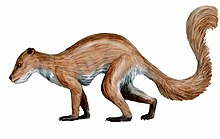Plesiadapiformes
| Plesiadapiformes Temporal range:
Middle Eocene[1] | |
|---|---|

| |
| Plesiadapis | |
| Scientific classification | |
| Domain: | Eukaryota |
| Kingdom: | Animalia |
| Phylum: | Chordata |
| Class: | Mammalia |
| Clade: | Pan-Primates
|
| Order: | Plesiadapiformes Simons and Tattersall, 1972 |
| Groups included | |
Plesiadapiformes ("
Plesiadapiformes first appear in the fossil record between 65 and 55 million years ago,
In the following simplified cladogram, the crown primates are classified as highly derived Plesiadapiformes, possibly as sister of the Plesiadapoidea.[7] The crown primates are cladistically granted here into the Plesiadapiformes, and "Plesiadapiformes" become a junior synonym of the primates. With this tree, the Plesiadapiformes are not literally extinct (in the sense of having no surviving descendants). The crown primates are also called "Euprimates" in this context.
| Euarchontoglires |
| ||||||||||||||||||||||||||||||||||||||||||||||||||||||
Alternatively, in 2018, the Plesiadapiformes were proposed to be more related to Dermoptera, or roughly corresponding to Primatomorpha, with both Dermoptera and the primates emerging within this group.[13][14][15] Also in a 2020 paper, the primates and Dermoptera were jointly considered sister to the plesiadapiform Purgatoriidae, resulting in the following phylogenetic tree.[16]
| Euarchontoglires |
| ||||||||||||||||||||||||||||||||||||
Traditionally, they were regarded as a separate extinct order of Primatomorpha, but it now appears that groups such as the extant primates and/or the Dermoptera have emerged in the group.[citation needed]
Similarly, in 2021 the Purgatoriidae were classified as sister to Dermoptera, while the rest of the Plesiadapiformes appear to be sister to the remaining primates:[8]
| Euarchonta |
| ||||||||||||||||||||||||||||||||||||||||||||||||||||||
One possible classification table of plesiadapiform families is listed below.
- Plesiadapiformes
- Family Micromomyidae
- Superfamily Paromomyoidea
- Family Paromomyidae
- Family Picromomyidae
- Family Palaechthonidae
- Family Microsyopidae
- Superfamily Plesiadapoidea[17]
- Family Carpolestidae
- Family Chronolestidae
- Family Picrodontidae
- Family Plesiadapidae
- Family Saxonellidae
References
- ^ "Plesiadapiformes". paleobiodb.org. Retrieved 10 August 2021.
- hdl:1807/71784.
- ^ PMID 28429568.
- ISBN 978-3-540-32474-4. Retrieved 25 January 2015.
- S2CID 37772289.
- PMID 19386655.
- ^ PMID 28429568.
- ^ PMID 35582793.
- ^ Paleontologists discover most primitive primate skeleton - PhysOrg.com
- ^ March 2021, Patrick Pester-Staff Writer 04. "Primate ancestor of all humans likely roamed with the dinosaurs". livescience.com. Retrieved 5 March 2021.
{{cite web}}: CS1 maint: numeric names: authors list (link) - .
- S2CID 4369153.
- S2CID 54167483.
- ISBN 9781119179313
- PMID 29935935.
- S2CID 215550773.
- ^ "Plesiadapoidea". paleobiodb.org. Retrieved 1 March 2022.
